Wattle Park
The Built Environment - Box Hill
We grew up in Box Hill South in close proximity to Surrey Hills where our family has had an association for five generations. 28 Moore Street was our family home. We all spent our childhood and early adult years there, before moving out on our own. The family ventured out into Box Hill in 1946 when our parents bought a block of land in a new subdivision. They paid one hundred pounds plus ten pounds in taxes. Jim and Alice also looked further out in Donvale, where, for a fraction of the cost, they could have purchased two acres of bush. Unfortunately this was not an option as there was no public transport and we did not own a car.
After the war, Box Hill South was opened up for new housing. The City of Box Hill revised its land valuation system and residential subdivision started to boom across the municipality. The small holdings of mixed farming and orchards, were quickly replaced by the unmade road network of the subdivisions. Electricity and gas were provided, but no sewerage until the 1950’s, so it was outside toilets for all.
Our parents could not afford to have the house built, so Jim decided to build it himself. He bought a book on basic carpentry and the tools, all hand tools of course, and proceeded to build. The house is still there today, straight as a die.

It was a very liveable and rather nice design, set on stumps, weatherboard cladding and with a low slung, pitched roof. It had the standard three bedrooms, one bathroom, kitchen, dining room, lounge room and laundry. When first built there was an outside toilet attached to the single garage that also had a chook pen attached to it.
Over time, the surrounding paddocks filled with houses and our house changed a little too. The view of the Dandenongs from the french doors in the lounge room disappeared, the toilet moved inside and our grandparents built a flat on the back. The addition of the rumpus room and flat spoilt the spaciousness of the living rooms and the back garden. The old weatherboard garage, toilet and chook pen were removed and a new double garage and new chook pen took the new additions to the back fence.
Little appears to have changed externally to the house since Mum sold it about 1981.
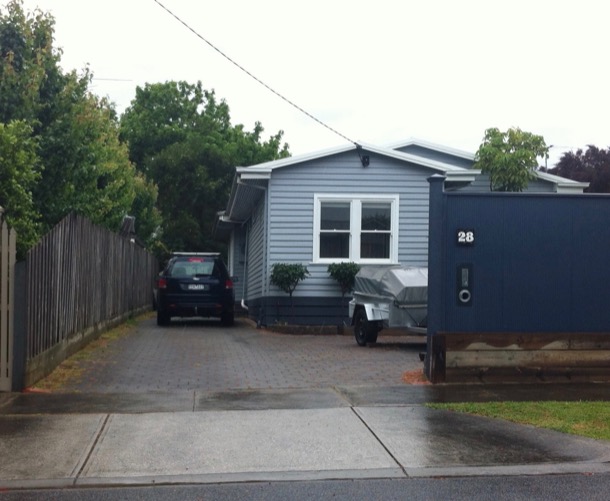
When we were children, Wattle Park itself consisted of large trees with mown grass underneath, like a traditional park, but with native trees and grasses. It was owned and maintained by the Tramways Board, responsible for the tram system in Melbourne. The Tramways brass band played in a rotunda every Sunday in the park. Nowadays those grasses are no longer mown. It looks much more like remnant bushland.
The 137 acres opened as a public park in 1917.
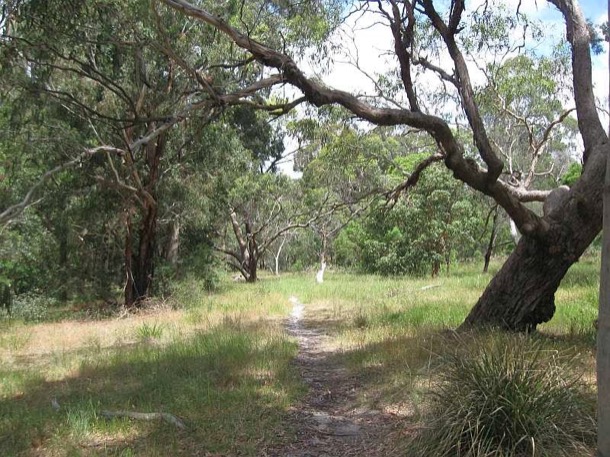
The chalet, designed and built by a Tramways architect, opened in 1928. it was promoted as a dance hall and wedding reception venue and, amazingly, it still is. It is listed on both the Heritage Victoria and National Trust Registers.
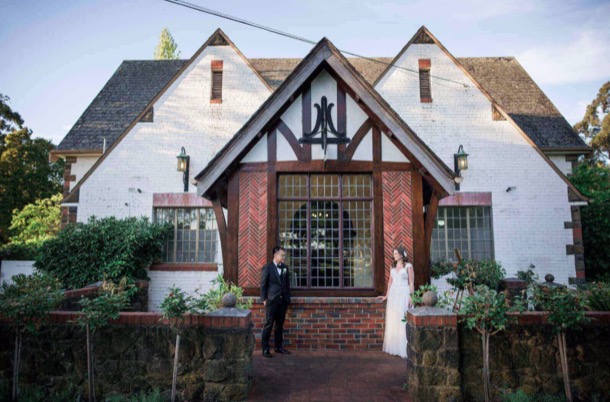
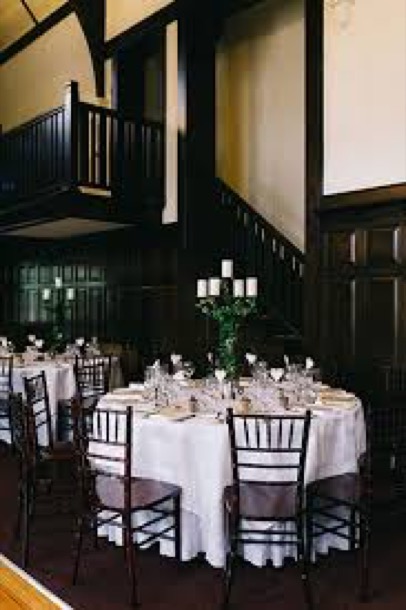
Our own parents’ wedding reception was held there in 1945, after they had been married at the Wyclif Surrey Hills Congregationalist Church in Surrey Hills.
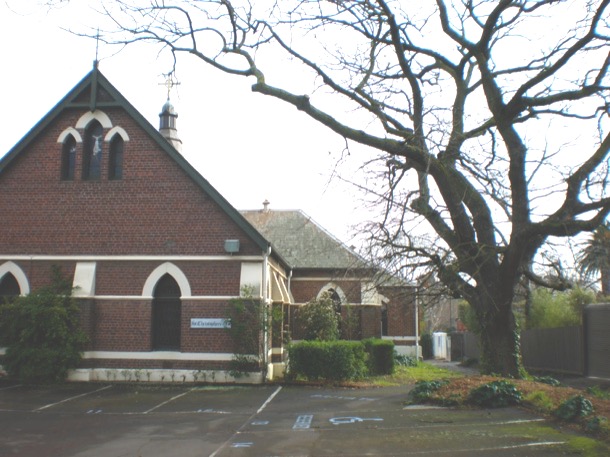
Box Hill Gasworks is now gone, but it was an important part of our parents' history. It was built early in the history of Box Hill:
7/1/1890 The Argus
Some twelve months ago the Nunawading and Boroondara councils granted permission to Mr. Thomas Coates, hydraulic engineer, to lay down gas mains in the streets of the two shires. Mr. Coates purchased an eligible site near Elgar road, Box Hill, upon which to erect the gasometer and the other necessary buildings. At the present time all the mains have been laid down in the shires named, and Mr. Coates is now in a position to light up Surrey Hills and Box Hill with gas. The local works are of such a nature that Mr. Coates contemplates being able to supply the wants of the district for many years to come without enlarging the gasworks. Last night a trial was made in Box Hill and Surrey Hills, when the corporation lamps were lit with gas for the first time. Illumination works were erected at the intersection of the leading streets. The trial was considered a very favourable one, the gas burning bright and clear. In connection with the lighting of these shires with gas a public banquet will be held in Surrey Hills next Monday night.
Over time three gasometers were built.
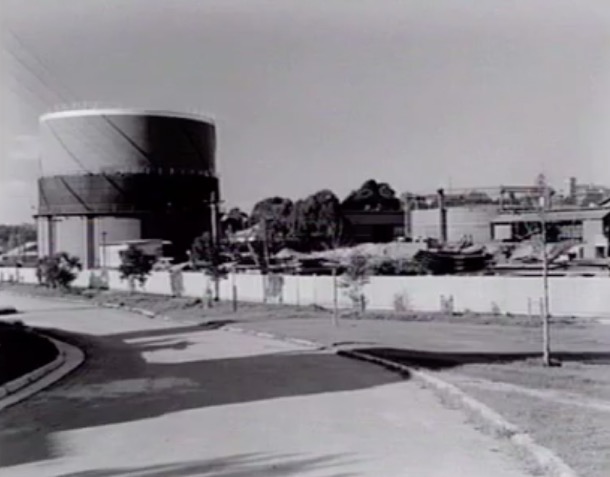
We don't know exactly when Jim started work at the Box Hill Gasworks, but in 1945 he left the Maribinong Munitions factory, where he had spent the war years. It was that year when our parents married and Jim moved into his in-laws’ Surrey Hills house. Soon after, he started work at the gas works as an analytical chemist. He worked there until began teaching in 1954.
Sue remembers him riding his bicycle to work, and later, a motorbike.
He worked in the laboratory, doing things like checking the calorific value of the gas.
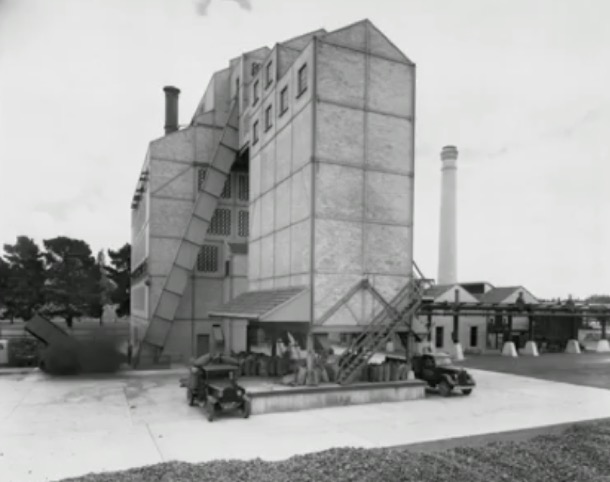
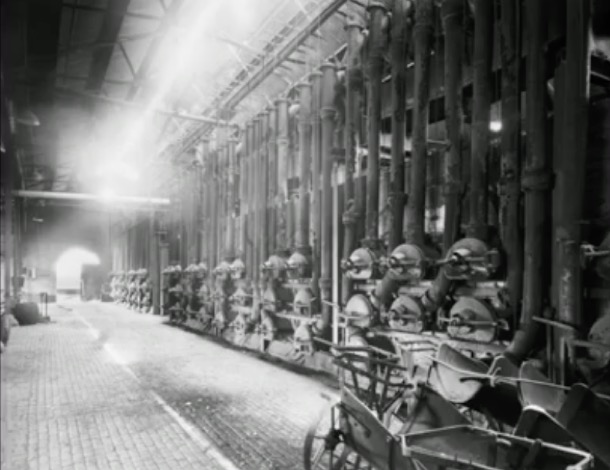
Melbourne’s gas supply was made from Latrobe Valley brown coal, sent by rail to the various gasworks, owned by Colonial Gas Company. Box Hill was one of the biggest. As Melbourne expanded after the war, the demand for gas meant that the various gas works were very busy.

But, by 1960, substantial natural gas reserves had been discovered around Australia. Over the next five years all the Gas plants in Melbourne had closed down, and over 1000 workers were made redundant, by the discovery of natural gas deposit in Bass Strait. Over one million gas appliances in Melbourne were converted to natural gas in 1968. We remember the conversion time. There must have been plenty of publicity. Natural gas has no smell, and, for safety, they put in an additive to make it smell quite strongly. The flame was slightly different, but all the existing burners still worked.
The Gas Works are long gone. Box Hill Institute now occupies the site.
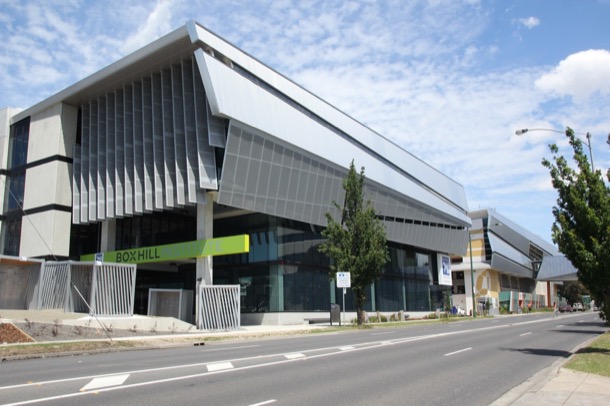
One of the fortnightly highlights in our simple lives was a trip to Box Hill Library. We loved this excursion, as we spent many hours reading on our beds. Books were expensive and we only owned a few. We had to rely on the Library so that we could finish our favourite series like Famous Five and the Billabong Books. It was very exciting if the next book in the series was on the shelf.
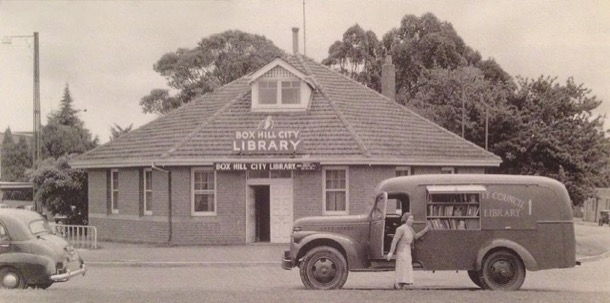
This small brick building was opposite the Town Hall at the end of the shopping centre. Whitehorse Road always had a wide, tree lined median strip, as it does today, and the library was right in the middle. It was later replaced by a grand modern library, but the small brick building is still there.
In our childhood, a trip to Box Hill shopping centre was quite an excursion, involving a four mile walk. In 2019 Google Maps says it takes thirty two minutes, but with small legs and a pusher as well, maybe it took a little longer. I remember it was fun and not arduous at all. The route went through suburban streets until Canterbury Road and from there it was ovals and open ground.
Box Hill Brickworks was one of the best sights on the walk to Box Hill, as the brickworks were still in full production. We marvelled at how small the men and carts were at the bottom of the quarry, and watched the procession of carts pass up and down the steep rail track to the actual brick works.
Box Hill Brickworks was founded in 1884 and was one of fifty or so brickworks throughout Melbourne, producing bricks, tiles and pipes for the building boom and ever expanding city. During the working life of the brickworks the clay was extracted from two clay holes or quarries. The first became Surrey Dive which became a popular swimming venue, but off limits to us. Sometimes however, we also gave ourselves the horrors, looking at green, mysterious waters. There were rumours of 'the dive' being bottomless and of swimmers disappearing in its murky depths. One story was of a man who took a very deep dive off the cliff side and simply disappeared. Some time later his body surfaced in Blackburn Lake, five kilometres away. No wonder we looked in awe and horror through the fence.
Today Surrey Dive is an attractive small urban lake used for swimming and remote controlled boat races.. A walking track around the ‘old dive’ and the brick works is planted with indigenous vegetation and a relaxing and attractive area.
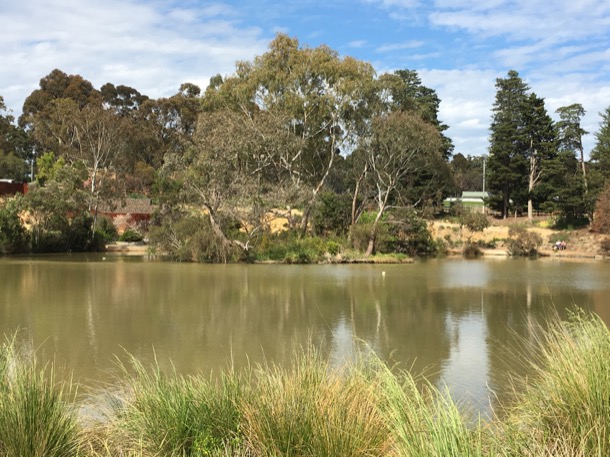
The other clay hole was the quarry that was in operation doing our childhood. It was adjacent to the brickworks and kiln, now derelict but still heritage listed. Unfortunately no restoration work has been carried out. The kiln itself was a massive, red brick building constructed on two levels and, of course, with a huge brick chimney.
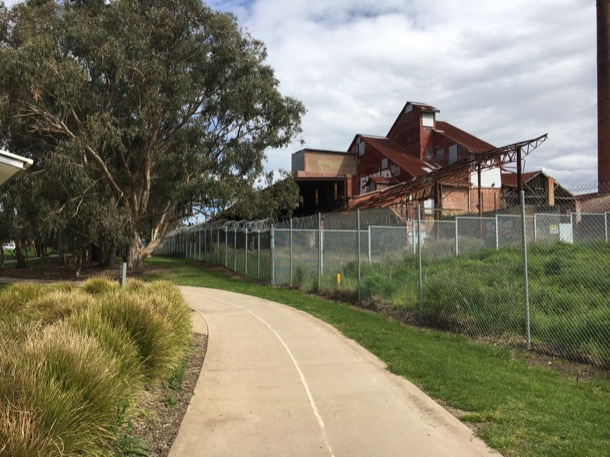
The quarry that was still in full production in our childhood, is now completely filled in. That cavernous hole in the ground is now a large mound covered in every weed known to man. On the horizon above the weeds, are the sky scrapers of twenty-first century Box Hill.
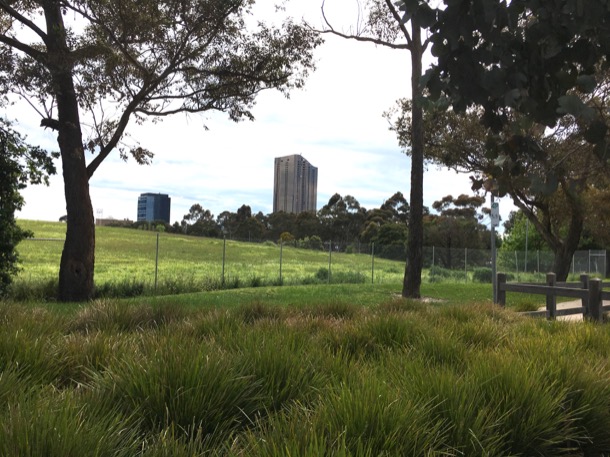
Box Hill shopping centre developed as a commercial centre, as soon as the railway line between Hawthorn and Lilydale was finished in 1862. It became an important transport hub for the eastern suburbs and beyond. During our childhood, Box Hill was the shopping destination for a big purchases. For instance, I can remember choosing a ‘walking’ doll with opening and closing eyes for a birthday present and the excitement of choosing a winter coat with a brown velvet collar. Another favourite shop was the delicatessen where such delicacies as rollmops, sauerkraut and frankfurters could be bought. Amongst the many single fronted small businesses were several large shops such as Taits haberdashery on the corner of Whitehorse Road and Station Street and Maples furniture shop. We also had a Coles variety store that sold anything from socks and singles to cosmetics, and MacEwans Hardware whose slogan was, “You can do it with McEwans because we’ve got a million things.”
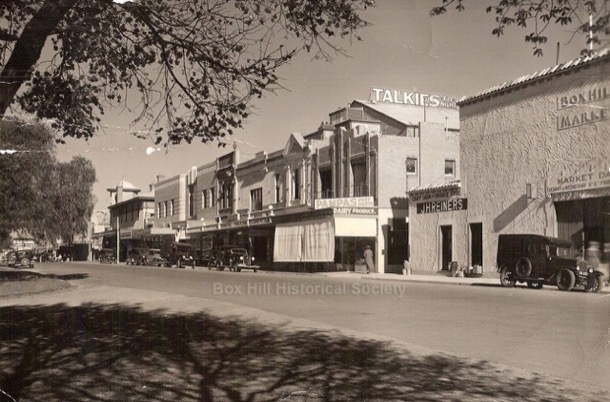
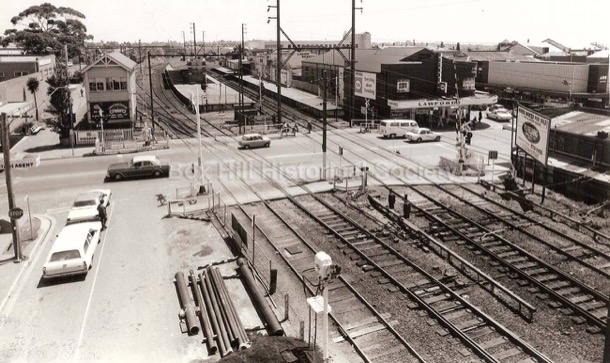
This is a photograph of Box Hill Station and the surrounding shopping precinct in the 1960s. In the centre of the photograph is the old station, that is now underground. Today, above ground, occupying the whole block surrounding the old station, is Box Hill Central and surrounding shopping malls. The signal box, the tall structure on the left of the railway gates is now occupied by the thirty-six storey golden residential tower, called Sky-One.
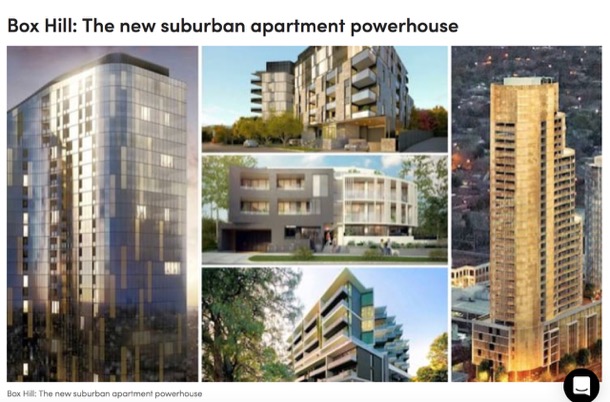
In the twenty-first century, Box Hill, as a commercial centre and transport hub, continues to influence the built environment around it, as you have no doubt witnessed. Officially designated as a development hub, Box Hill now sports high rise office and apartment towers. The streets we once drove down are now shopping malls, the station is underground, the railway gates are long gone and the strip shops have been replaced by a multi storey modern shopping centre. When we were children the shopping crowds were white and Anglo-Saxon. Today they are predominately Asian and the shops and restaurants reflect the change in population.
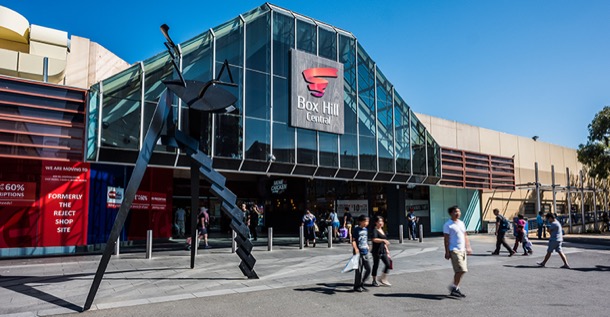
When we, as a family, first started going to the local Presbyterian church, it was called Presbyterian, Wattle Park. We had PWP embroidered on the front of our blue gym uniforms. This was before the advent of the Uniting Church. Church services were held in a cream brick building, called Forsythe Hall.
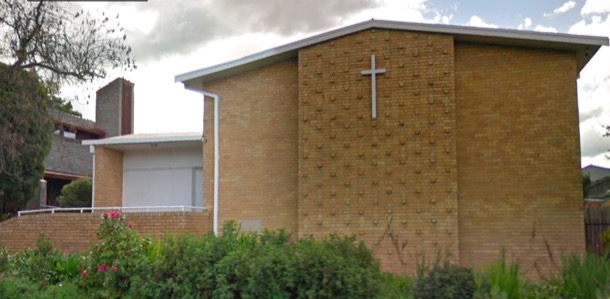
Attached, behind it, was an older little wooden building. During our childhood, this wooden building, Staley Hall, was used for a kindergarten during weekdays. In the evenings, various groups used it, including church boys’ and girls’ clubs (PBA and PGA) and the mixed club (PFA- Presbyterian Fellowship Association), we went to as teenagers. Sue and I both learnt to dance there, and I broke my front teeth on the heater in that room.
We have many memories of Forsyth Hall… dances, performances, Saturday afternoon movies, gym classes and, of course church services.
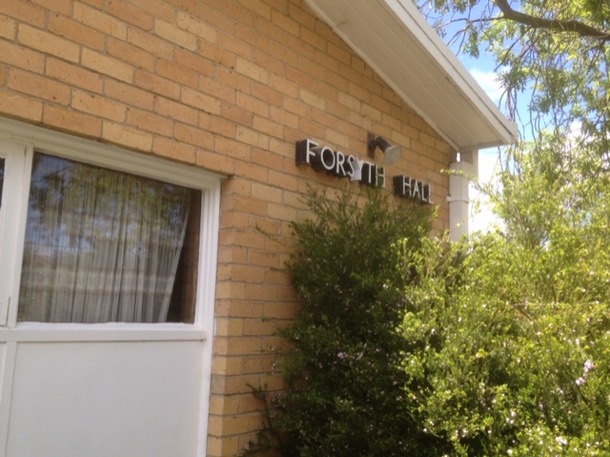
Both our parents were Elders of the church. Our mother taught Sunday School, our father ran the PFA for a while, and was on the board of management. The church was their only real friendship group, and was the only social life we had, as a family.
In the early 1960s the church community began the project of building a new church on the site. The size and scale of the project was a source of much disagreement between our father and others on the management committee.
In the end, a very grand architect designed building was commissioned. The new building was designed by well known architects Chandler & Patrick. An 1887 pipe organ was relocated from a church in Melbourne and extensively rebuilt. The new church, renamed St James, opened in 1965.
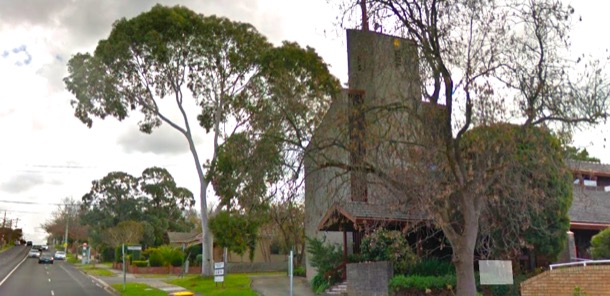
I loved it, because I sang in the church choir, and it had a choir loft at the back and great acoustics.
The buildings are still there. Sue and I visited as a detour on our “back to school” walk in 2016.
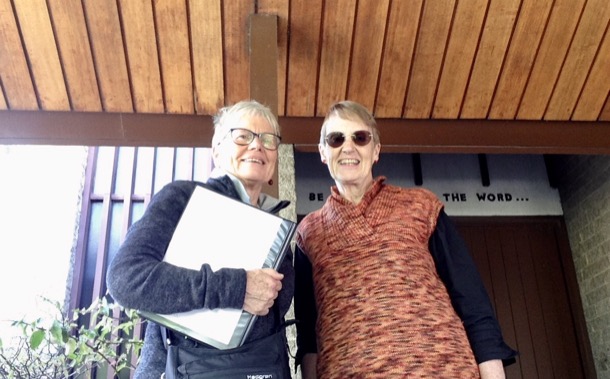
Comments
Meat and Three Vegs
07 09 17 17:26 Filed in: Children 1950s
Like many families, we were fairly poor as we were growing up. There were four children, only our father worked and "stuff" was very expensive. Food, however was relatively cheap, locally produced, fresh and plentiful by the time we Baby Boomers were on the scene. Our mother had been taught to cook by her mother, and the repertoire was pretty simple and limited in scope. Our mother was an ok cook. She knew not to boil the proverbial out of the cabbage, she used the limited available range of flavourings sensitively and she was open to the few new ideas that came her way.
As the fifties became the sixties, there was a fridge rather than an ice chest, the Womans' Weekly began to suggest new adventurous culinary ideas and there was a greater range of food in the shops.
In early 1964, when I was twelve and Sue was fifteen, our mother got sick. She had a condition called Thrombocytopenia, or low platelet count. Platelets allow blood to clot, so a person with not enough of them is in danger of haemorrhage. Eventually she had her spleen out and recovered. But for that year, she was tired all the time and generally felt terrible. Our youngest brother was only seven.
I remember a conversation early that year with a very serious Mum and Dad, just with me. The proposal they were putting to me was that I take on all the family cooking, to remove that burden from Mum.
I had been a kitchen assistant to her for a number of years. My memory of those years was that Sue cooked occasionally and always special, flamboyant things like interesting cakes, and that it was me who made the gravy and the custard, peeled the apples or rubbed the butter into the flour, often with my mother shutting the drawers in front of me, or wiping up my spills, complaining about how sloppy I was. (I still am!)
So, at age twelve, I became the family cook.
We hardly ever used actual recipes. Most meals were just cooked the way generations before had cooked. Even so, recipe swapping as a social activity was as prevalent then as it still is. Mum’s recipe book often had the name of the source: Joan’s biscuits, etc. Sometimes they were written on the back of an envelope or a scrap of paper and stuck in. There were also torn out recipes from magazines and newspapers. And there was also the PWMU cookbook.
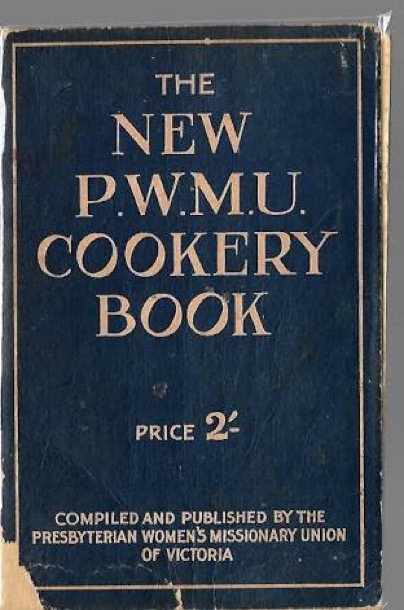
We were a family of six. We had an evening meal of meat and vegetables and dessert.
Three meals a day and morning tea were provided. Nothing was drunk with any of our meals, not even water. There would have been a cup of tea afterwards, but not at the table. After school and other hungry times we had unlimited access to bread and butter, and fruit. (almost exclusively apples and oranges). I remember mum saying, “fill up on bread”.
Evening meals
We always had meat, served mostly with potato, but sometimes white rice. Also on the plate were two or three other seasonal veggies. These included cauliflower with white sauce; lightly cooked shredded cabbage; diagonally cut string beans; fresh peas; boiled silver beet; carrots cut in rings; mashed pumpkin; brussel sprouts, cooked whole; carrot and parsnip together mashed with butter; marrow cut in rings, boiled and served with lots of butter, salt and pepper; leeks in white sauce; broad beans, included the pods. In the summer we often had a salad made from iceberg lettuce and tomato and some of: green capsicum, celery, peeled cucumber, and, later on, the very glamorous addition of chopped apple and orange. The salad was liberally dressed with home made salad dressing. This was made by beating up a tin of sweetened condensed milk with mustard, malt vinegar and salt. We also had pickled beetroot.

Here is a fairly comprehensive list of the “meat” part of the meal:
- Roast leg of lamb, roasted with potato, pumpkin, parsnip and onion. This was served with a green vegetable cooked separately; gravy, made in the roasting pan from thickened meat juices; and freshly made mint sauce. Dad was always the one to carve, but not ceremoniously at the dinner table, rather, at the kitchen bench and the portions were doled out from there.
- Roast beef, “corner cut”, roasted with the same vegetables.
- The same roast meats, served as cold meat or fritters, with chutney.
- Grilled loin chops, two each.
- Corned beef, boiled. Warm with cabbage and potato, then as cold meat on subsequent nights.
- Four quarter lamb chops, stewed with onion, carrot and peas. Served with mashed potato.
- “Rice meat” - chopped veal, stewed with onion, stirred into plain white rice, peas, parsley and lots of pepper.
- Smoked cod, boiled.
- Steak, corner cut sliced about a centimetre thick, fried in the frypan, until it was grey inside and hard on the outside, served with worcestershire sauce.
- Lamb shanks stewed with carrots and onions.
- Gravy beef (stewing beef) stew. Served with mashed potato and other vegetables.
- “Mr Wilkinson dinner” - boiled white rice, topped with minced steak cooked with mushroom soup, and shredded, lightly cooked cabbage. (This meal was introduced to us by the eponymous Mr Wilkinson while the two families were camping at Shoreham. On a two burner stove, it fed four adults and ten children.) (I still use this as a meal, although these days, I use a tin of lentils and fresh mushrooms.)
- Spaghetti served with meat sauce (fried onion, tinned tomato and minced steak, thickened)
- Ham steak and pineapple. (both fried in dripping)
- Sausage meat rissoles, fried in dripping and served with mashed potato and “tomato sauce gravy”. The gravy was made by browning a big spoon of flour in the frying pan, then adding tomato sauce and water.
- Pan fried fish. This was usually barracuda, bought at Vic market, served with chips bought from the Wattle Park fish and chip shop.
- “Chow Mein”. This was made in the frypan: minced steak, dried chicken noodle soup, pineapple pieces, green pepper, shredded cabbage. Served with boiled white rice.
- Meatballs made of minced steak flavoured with dried soup mix and cooked in a sauce made of tomato soup and chopped green pepper and tinned pineapple. Served with boiled white rice.
- Lambs fry, (liver) fried with tomato sauce gravy, served with mashed potato
- Camp Pie (like spam) and tinned real ham - almost exclusively when we were camping.
Mum’s father, over the years when I was the family cook, lived alone in the flat the the back of our house. He also had to be catered for, and he had very specific tastes. He shared the dessert I had made, but for his main course, he insisted on his own menu. He would have on alternate nights, two grilled chops or stewed lamb shanks. And he didn’t even have the same vegetables as the rest of the family. He only had potato, carrots and beans. This meal was delivered to him before the rest of the family ate. I remember Mum wryly saying that he thought he was very easy to feed, because he had such simple tastes. Occasionally there was a complaint, delivered indirectly to me via Mum. Too much salt on the grilled chops, is one I remember.
Desserts
Dessert was a staple. We had it every single night. It nearly always had some fruit component and was served with home made ice cream (evaporated milk, sugar, vanilla, eggs), custard (made with custard powder and egg), sweet white sauce or “top of milk”, from the top of the unhomogenised milk, a bit like thin cream.
Apple sponge
Apple crumble
Baked whole apples, sometimes covered with pastry.
Jam roll
Bread and butter pudding
Steamed pudding - plain with jam in the bottom, served with custard, or butterscotch made with golden syrup, served with sweetened white sauce.
Tinned fruit
White rice with sugar sprinkled over it served with milk
Rice pudding
Jelly with fruit set into it
Golden syrup dumplings
Apple snow
Sago, cooked in a white sauce (looked like frogs’ eggs)
Junket, like a baked custard, with nutmeg sprinkled on the top.
Baked fruit, or sometimes tinned fruit, with a crunchy topping made with Weeties, sugar and dotted with butter
Banana custard
Television pudding. this was a self saucing chocolate pudding. It was Dad’s mother’s recipe, always called this, even though long before had a television.

Apple Sponge
Breakfast
Weeties or Cornflakes with sugar and milk
Winter: porridge, with creamed oats (Creamota), sprinkled with brown sugar or golden syrup and milk.
Toast only on weekends or holidays
School lunches
Mum would get up early and stand at the bench in the corner and make lunches for the four kids and Dad, who was a teacher. She used the white bread that had been delivered the day before. She would slice the bread (at least fifteen slices). The butter was softened under the grill. We each had a round of savoury filling, cut into four little squares, and half a round of something else, often sweet. Fillings for the big one were always protein based, such as cold meat and chutney, cheese and chutney, egg and lettuce, baked beans, cheese and sliced green capsicum; and the smaller one was honey, jam, peanut butter and chopped dates, sultanas etc.
There was always homemade cake or a biscuit and either an apple or an orange. Cakes were boiled fruit cake, spice cake, queen cakes (like cup cakes), orange cake, and the biscuits we remember are anzacs, coconut biscuits and custard powder biscuits.
The food was wrapped in greaseproof paper and all put in a brown paper bag.
We didn’t take drinks to school. The school had drinking taps, and we always had a third of a pint of milk at morning play, provided by the government. In summer it was warmed and occasionally even curdled by the sun. We coveted, but didn’t have ourselves, “flavoured straws”, where one sucked the milk through straws coated on the inside with chocolate or strawberry flavouring.
Very, very occasionally there was a lunch order. I remember big mugs of tomato soup, and hot pies.
Weekend Lunches
Scrambled eggs on thick slabs of buttered toast
Poached eggs (two each) also on buttered toast
Fried eggs, cooked in the frypan, so they came out square
“Hamlet”. This was eggs and milk beaten up together and fried in butter in the frypan. It was served as thick pale slabs, served often with tomato and onion sauce.
“Spaghetti muck”. Fried bacon bits and onion into which was stirred eggs, cooked spaghetti and tomato sauce. (Ian’s favourite)
Baked beans on toast
Large boiled frankfurts, sometimes served with sauerkraut which we bought from the Box Hill delicatessen.
Tinned tuna in white sauce, served on toast.
Toasted cheese, slightly blackened blisters of processed cheese on big slabs of white toast.
Treats
Interestingly, desserts and homemade cakes and biscuits were not seen as treats, just part of our normal diet.
- Cocoa, made with whole milk with lots of sugar
- Broken biscuits from the delicatessen - sweet or savoury
- Pancakes with sugar and fresh lemon juice
- Mixed cakes bought from The Golden Rule (the milk bar at Wattle Park) These were very carefully cut into smaller pieces and meticulously shared out. They included vanilla slices, laminations, neenish tarts, small bakewell tarts, apple slices, jam tarts, lemon tarts
- Homemade toffee. (made with brown sugar, butter and sweetened condensed milk.)
- Lollies. This involved walking to the shop and choosing. Lollies were sold as “so many a penny, or halfpenny”. But there were also larger ones like choo choo bars, crunchy bars, poly waffles, cherry ripes, packets of fags, musk sticks, chocolate covered caramels, liquorice straps etc.
- Icy poles and ice creams. Water icy poles were common. Ice creams mostly meant a scoop in a wafer cone. There were three flavours: vanilla, chocolate and strawberry. (Incidentally I, Margaret, was promised six ice creams if I stopped biting my fingernails. I did, and I ate them all, one after the other!)
- Birthdays - the family dinner as per usual and then a home made sponge cake, filled with cream with white icing on top, candles and our personal flower. This was whatever was in season on our birthday. Sue’s (August) was hellebores, mine (September) was crab apple blossom.
- Take away dinner. Some time during our early childhood, a Box Hill Chinese restaurant began selling food as take away. Prior to that, at least in our world, there had only been Fish and Chip shops, (and we only ever got chips and potato cakes), bakery products like pies and sandwiches and a rare lunch time visit to Ball and Welsh cafeteria with Auntie Marge. So, occasionally, we would take two or three saucepans (no take away containers then) to the Chinese Restaurant and bring home exotic wonders like Chicken and Almonds, Sweet and Sour Battered Pork, Beef and Green Pepper and Special Fried Rice.
- When we were camping, there were other treats: cordial, made up from little bottles of concentrate and huge amounts of sugar; toast (we had sliced Home Pride bread there) with butter and vegemite or marmalade for breakfast. Drumstick ice creams as a reward for the long walk to the store. Then, on the long way home in the car, at the end of at least six weeks’ camping, there would be the bag of lollies bought with all the saved and hoarded pocket money. I remember the difficult decision - quality or quantity? I was disappointed the year I chose several packets of lifesavers, but, equally upset that a few special lollies disappeared far too soon.
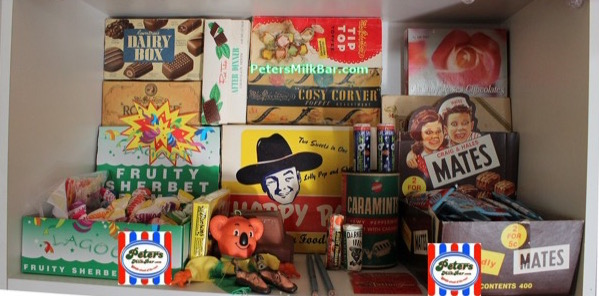
Table manners
We ate dinner either at the kitchen table or around the big blackwood table that had been our grandmother’s. There was a table cloth and cloth serviettes in serviette rings, and the table was properly set. Dad and the boys had to wear a shirt to the table, even if it was very hot.
At least for a while, Grace was said. ‘For what we are about to receive may the Lord make us truly grateful, Amen.” If Grace wasn’t said, then the signal to begin was when the last person sat down at the table.
We had to hold our knife and fork correctly and chew with our mouths shut. I remember being admonished, “Don’t enjoy your food so much, Margaret.”
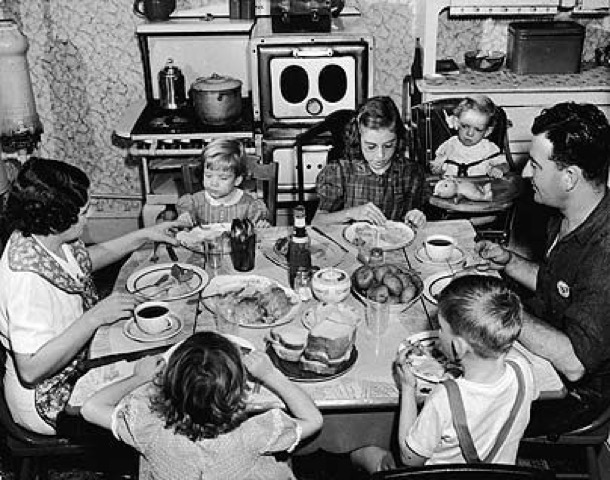
When we were on holidays, these strictures were lifted. We remember having rowdy toast eating competitions, and Dad being so disgusted that he made us eat our toast the way he had had to at boarding school. This involved putting the butter and jam on the side of the plate and cutting and spreading bite sized pieces of toast. It slowed us down, but the bonus was that you could eat much more butter that way!
Weekend lunches were also very informal. Later, when we had television, some of us ate lunch in the lounge with the TV on. We remember World Championship Wrestling being one of these lunchtime offerings, with our young brothers wrestling on the floor in front of it. Although we went to church every Sunday, lunch was still very informal.
Rubbish
We had one smallish galvanised iron rubbish bin, emptied weekly. There were never any left overs, but food scraps, such as peelings and well sucked bones were wrapped in newspaper and placed directly into the bin. There was very little packaging in those days.

Here is a drawing of the kitchen all this took place in:
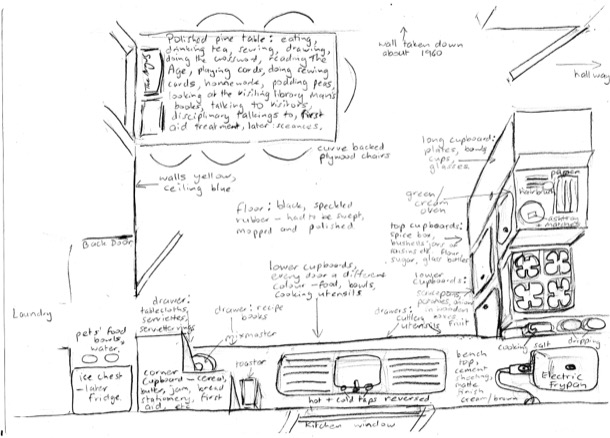
Shopping
All of this food cooked for this family of six plus one needed to be bought of course. Weekly shopping was the norm, as we only had a small fridge. The freezer compartment was only big enough for two trays of homemade ice-cream and ice blocks. A weekly shop for meat, fruit vegetables and a few groceries was all done without a car. This was the era of the local shopping strip with its butcher, greengrocer, grocer, newsagent and chemist. The Wattle Park shops were a little bigger, maybe because they were at a tram terminus. We also had two chemists a bank, a Mensland, that also sold our school uniforms, a wool and haberdashery shop, a barber, hairdresser, two milk-bars, and a cake shop. There was also a mysterious large shop crammed to the ceiling with all sorts of fabric, cottons and general clothing. Mr. Kline, a round bald headed man with a strong European accent owned and served in the shop . He was the only out of the ordinary person in this very suburban, white, Anglo Saxon world.

Mum walked down to the shops, probably on Fridays, shopping list in hand, and with children if they were still at home and not yet at school. Groceries, green groceries and the meat of course from the butchers were all left at the small supermarket for Dad to collect in the car after school. We cannot remember how the shopping got home in the very early days before the supermarket was built and when Dad rode his bike to work.
What would have been on the Shopping List:
NOT Bread and Milk as it was delivered daily
Tea [leaves of course]
White Sugar
White Flour - Plain and Self Raising
Cornflour
Custard powder
Icing Sugar
Vanilla
Cocoa
Coconut
Sultanas/Raisins/Currants
Dates
Jam in Tins [Plum, Raspberry, Marmalade}
Golden Syrup
Vegemite
Saxa Table Salt
Baking Powder
Bi Carb
Cinnamon
Nutmeg
Mixed Spice
Pepper
Tomato Sauce /Worcestershire Sauce
Keens Mustard Powder
Sweetened Condensed Milk
Tinned fruit
Tinned pineapple
Tomato soup
Baked beans
Tinned tomatoes
Tinned tuna
Chicken Noodle Soup
Powdered Mushroom Soup
White rice
Spaghetti
Malt vinegar
Butter
Kraft Cheese
Uneeda or Thin Captain Biscuits
Weeties / Cornflakes
Creamota Porridge
Rolled Oats
Rinso
Pine-o-clean
White Lily Paste
Jex
Velvet Soap
Toothpaste
Mum Deodorant [a white shiny paste]
Kiwi Shoe Polish
Dog and cat food
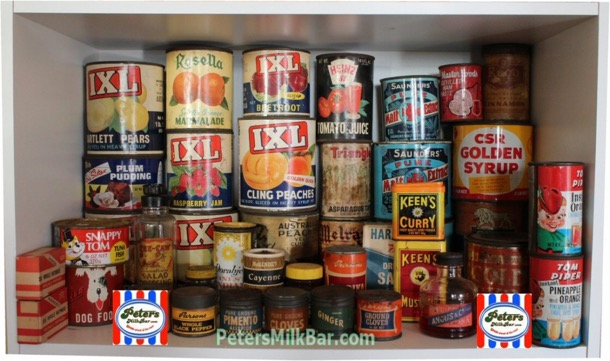
Everything we bought and ate was made in Australia.
Green Groceries consisted of the basics and was governed by seasonal availability. For instance we did not have tomatoes or bananas all year round and never had cauliflower in summer. Many of the fruits and vegetables that feature in our shopping today were unheard of, eg. eggplant, zucchini, avocado, asparagus, snow peas, all the asian greens, sweet potatoes, different varieties of potatoes, Spanish onions, fresh chilli, garlic or red and yellow peppers. As there was less variety, the shop was much smaller. Another difference was that you were served and did not touch the produce. No fruit or vegetables were wrapped or packaged. Your shopping was put into brown paper bags, wrapped in newspaper or just put into a box.
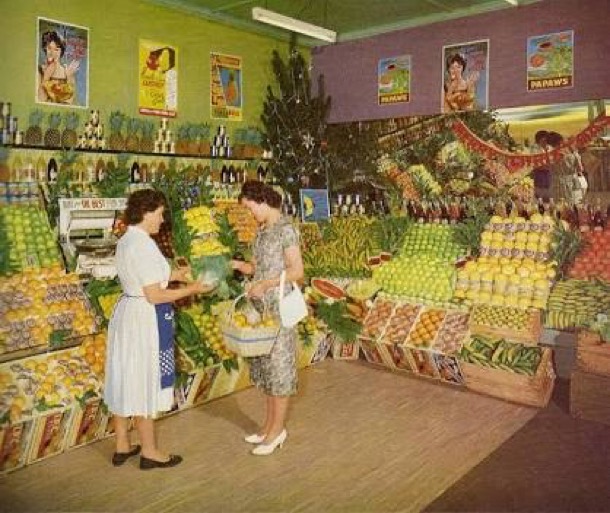
Meat was also very basic and varied little week to week. Once again the variety was not there, the bulk of the offerings being beef and lamb. The order would have been mince, lamb chops, gravy beef, a roast [that did 3 meals] and maybe lambs fry, sausage meat, shanks or smoked cod. Once again you were served and the goods were wrapped in shiny white paper and then newspaper.
Before the Supermarket opened in the mid fifties, other items were bought at the grocer. In the mid fifties the Foodland Supermarket opened introducing self service and the phenomenon of the checkout. There was now more processed food available, and we bought such items as Weetbix, dry and sweet biscuits in packets, baked beans, tinned fruit, Camp Pie and Kraft cheese. As the entire Foodland Supermarket consisted of two narrow shop length aisles the array was not vast and we only purchased enough to fit into three or four big stand up brown paper bags.
For a number of years when we were a little older, the weekly shop was done on Saturday morning at the Victoria Market. This was fruit and veg, meat from the big meat hall with the carcasses hanging from hooks on rails and fish from the fish hall.
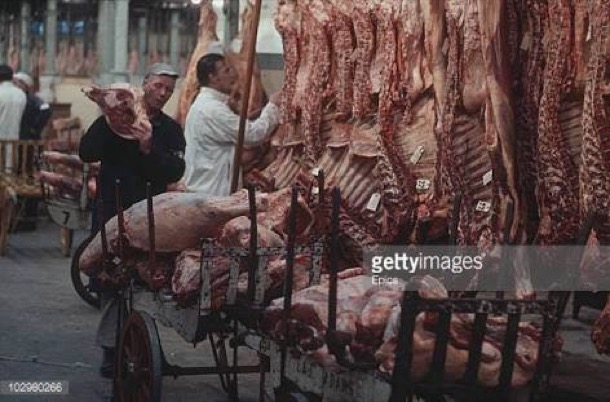
Besides going home with an abundance of food, obviously very cheap, the attraction was doughnuts and, believe it or not, the doughnut vans are still exactly the same, as is the smell freshly cooked doughnuts wafting in the air. The other special treat was a sweets stall: not the usual run of the mill lollies but big yummy humbugs and aniseed blocks and soft fat delicious liquorice. Best of all were the honeycomb blocks covered in thick good chocolate. Umm I can still taste it. It looked homemade and it all went home in crunchy brown paper bags.
The Victoria Market was an exotic and interesting diversion from weekly local shopping, but for most of our childhood, the weekly shop was done at the Wattle Park shops.

Wattle park shops from the tram terminus.
It must be remembered that shops were open on week days nine to five, and until midday on Saturday. After that everything shut down. Bread was in another category altogether, as no bread was baked on the weekends, not even Saturday.
An exciting diversion in our childhood, for maybe a year or so, was the advent of illegal bread baked on Sunday. Rebel bakers, defying the law, baked bread on Sunday and made it available to the public. In the days when few homes had phones, let alone mobiles and the Internet, word spread the old fashioned way: gossip. This initiative proved very popular, so much so that the trip to buy the bread needed to be made early in the morning or supplies ran out. We made the ‘long’ trip out to Blackburn, after Church to purchase our illegal bread. A few prosecutions were made for illegal baking and trading but the number of bakers increased, to fill the demand. Finally, the Government of the day gave in and repealed Section 105 of the Labour and Industry Act.
The Age in November 1958 reported on the heated discussions in Parliament, as rows over whether to allow bread to be baked legally intensified.
THE AGE, WEDNESDAY, NOVEMBER 19, 1958 18 Unhygienic Bread Feared. …Drivers. Labor claimed In the Legislative Assembly last night that the lifting of restrictions on one-man bakers would create an unhygienic state in the bread industry. They were strongly opposed to the Government's repeal of Section 105 of the Labor and Industry Act.
Today there is such an assortment of food and ingredients available for purchase everyday that it is strange to think of a world where a zucchini was an exotic vegetable, consumption of cheese was not an art form and chicken was from the old worn out layer from the chook pen, not bought from a shop. Coffee was Nescafe Instant and only the Italians in Carlton knew what an Espresso or a Cappuccino was. Today words like macrobiotic, whole grain, organic, grass fed and bio dynamic are used as slogans to persuade us to buy. We had very basic food made from fresh ingredients, the cheese may have been Kraft “soap” cheese and the bread white, but the meat was grass fed and the fruit and vegetables fresh and plentiful.

